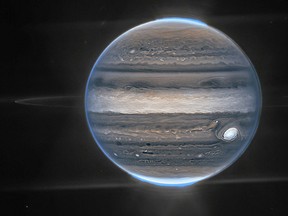Jupiter will orbit just 590 million kilometres from Earth — 375 million km closer than its farthest point — on Sept. 26-27, 2022

Attention, space geeks: Have you heard about Jupiter getting really close to Earth tonight?
Well, not really close. The giant gas planet, the largest in our solar system, will still be orbiting 590 million kilometres away. But that’s 375 million km closer than when it’s at its apogee, which is the space geek word for when it’s farthest away.
Start your day with a roundup of B.C.-focused news and opinion delivered straight to your inbox at 7 a.m., Monday to Friday.
Thanks for signing up!
A welcome email is on its way. If you don't see it, please check your junk folder.
The next issue of Sunrise presented by Vancouver Sun will soon be in your inbox.
Jupiter is viewable like a distant star for much of the year, but it will be especially bright and detailed in the night sky on Sept. 26-27 because it’s closer than it’s been to Earth since 1963 — yup, in nearly six decades.
We asked Marley Leacock, an astronomer and science educator with Vancouver’s H.R. MacMillan Space Centre, a few questions about how best to watch tonight’s rare space spectacle.
When is the best time of evening/morning to see it?
“Jupiter is in the sky pretty much all night,” says Leacock. “It rises in the east at around 7 p.m. and sets at about 7 a.m. tomorrow. The best time to view would be when it is highest in the sky, around 1 a.m. on Sept. 27.”
Why is it so easily visible right now?
“Jupiter’s visibility has to do with where Jupiter is, but also where Earth and the Sun are,” explains Leacock.
The first reason is that “Jupiter will be in ‘opposition.’ This means that Jupiter will be directly opposite the Sun from our perspective, putting Earth right in the middle of them. When the sun sets in the west, Jupiter will rise directly opposite in the east. Opposition happens about every 13 months.
“The second factor that makes Jupiter so bright is that it is also approaching perigee. Perigee refers to when Jupiter and Earth are the closest to each other in their orbits. Perigee happens about once every 12 months, and the distance between the planets will change due to them being on two different orbits. This perigee, the two planets happen to be in the perfect place to get the smallest distance.
“The combination of opposition and a close perigee makes the planet appear brighter in our skies.”
Is tonight the only time it will be fairly easy to spot?
“Not at all,” says Leacock. “Jupiter is usually visible 10 months out of the year, switching between early morning and late at night. After the opposition, it will start to be in the sky for shorter amounts of time as the months go on. By the beginning of November, it is already high in the nighttime sky by the time the sun sets, and it sets four hours before sunrise.”
By the end of March, it won’t be visible at all. But it will reappear by about the end of May 2023. The next opposition is in early November of next year.
Any tips on how to spot it? Would binoculars help?
“Luckily, Jupiter is very bright and easy to spot even in a light-polluted city (like Vancouver),” explains Leacock. “It appears as a very bright star in the sky. I always say to try to get somewhere dark anyways, just to see the stars that appear. An ideal location would be somewhere with high elevation with a clear view of the horizon, especially if you want to see the rise and set.
Leacock says typical binoculars will help magnify the planet, but it will still appear star-like. Those with higher magnification might allow you to see it in more detail and possibly even spot its Galilean moons.
True space geeks will want a telescope, though, as “most telescopes with a 60-90 mm aperture will give you a view of the cloud belts and the Galilean moons,” says Leacock.
More good news about tonight’s sky-watching event: the forecast is for perfectly clear skies overnight. Happy viewing.


